 |
Celebrating the “Fentennial”
First, I must confess that the cute term “Fentennial” is not my own creation. Three days after I paid a visit to Boston’s 100-year-old Fenway Park, I spent the day at the Baseball Hall of Fame and Museum in Cooperstown. There I found an exhibit that celebrated the 100th birthday of Fenway. The display was called “FENtennial.”
That exhibit is really something, too (below). It traces the history of the storied ballpark from its construction, through the building of the Green Monster, to the Red Sox winning teams of the ’60s to the two World Series-winning clubs of the last decade. And such an exhibit wouldn’t be complete if it failed to include the famous “bloody sock” (below right) worn by Curt Schilling in Game 2 of the 2004 World Series — which, of course, was played in Fenway.
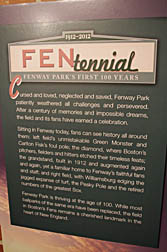 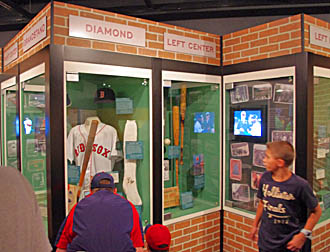 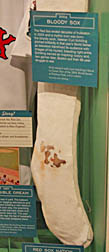 |
The 100-year history of this ballpark is as rich as any sports facility in the world. From high points like Ted Williams, All Star Games and World Series to decades of misery and frustration. Through it all, though, Red Sox Nation has loved its quirky, usually packed bandbox.
While the Red Sox have been successful in providing modern conveniences within the park, there is still an enormous amount of the past on display here. For example, outside are plaques and statues galore. One dedication plaque (below left), which isn’t nearly as old as it looks, is passed by everyone enjoying their pregame time on Yawkey Way. It not only honors the opening of the park in 1912, but also its renovation in 1934 and all of the enhancements added over the past ten years. There’s also a plaque honoring longtime owner Tom Yawkey nearby (below right).
Around on Van Ness Street is one of the great statues at any sports facility. Ted Williams is depicted placing a cap on a youngster’s head (below center). It’s not just any child, though. If you look closely, you’ll notice he has no hair. That’s because he represents a young cancer victim, because Williams cared very deeply about the Jimmy Fund Clinic at the Dana-Farber Cancer Institute. If you visit Fenway and don’t walk around to the south side of the park to see this statue, then you’ve missed seeing a true treasure. And like Ted himself, the statue is larger than life at eight-and-a-half-feet tall.
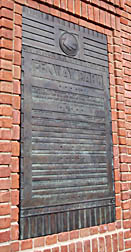 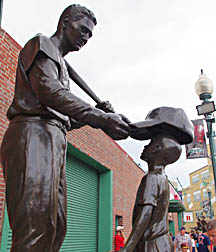  |
Inside the park are more historic treats. One of my favorites is the red seat in Section 42 (below left). This is where a home run ball landed off the bat of The Splendid Splinter in 1946. It’s considered to be the longest homer ever hit at the park … and it is indeed a long way from home plate (below right). In case you’re keeping score at home, this seat is Seat 21, Row 37, Section 42. Josh Hamilton, by the way, dropped a bomb of a homer not too far from this seat during the 2012 season.
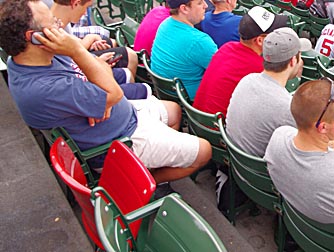 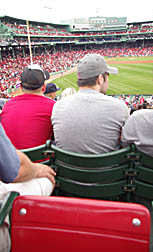 |
And over and over and over, you are reminded that Fenway is 100 years old, and that it’s America’s Most Beloved Ballpark. It’s on t!he walls, on every video screen and even on T-shirts. There’s no reason not to embrace it!
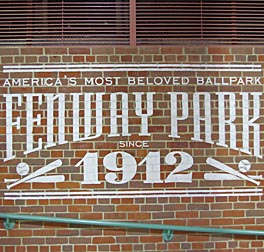  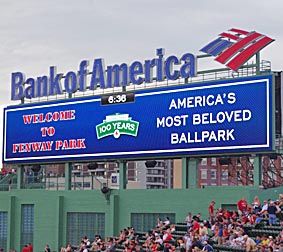 |
There are a number of elements that an old timer would not recognize about Fenway. Chalk these up to being modern conveniences that today’s fan — and sportswriter — demand.
One of the newest is a significantly upgraded concourse behind the right-field stands. Officially dubbed The Big Concourse, this 25,000-square-foot area opened in 2003. Here you’ll find a food court, lots of picnic tables, numerous TV screens to keep up with the action (the field is nowhere in sight from here), misting stations to cool you off and, very importantly, the newest and nicest public rest rooms in the ballpark. This concourse is shown below left.
And as you no doubt know, when the Red Sox ownership made a commitment to keep Fenway rather than build a new ballpark, they announced that in order to keep up with the Jones (you know, the Yankees) in revenue, they had to be creative in finding new spots for fans to (pay to) sit — or often stand. Most of those areas ended up being on top of the ballpark. For instance, the Coca-Cola Deck (below right) was constructed on the roof near the left-field foul pole in 2008.
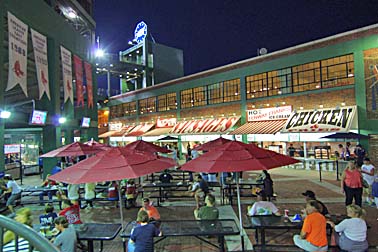 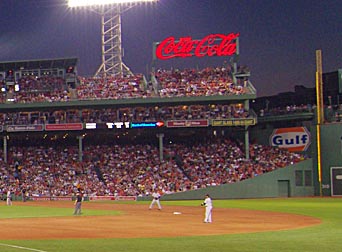 |
Another rooftop area was constructed high above the right-field grandstand. The Budweiser Rightfield Roof (below left) made its debut for the 2004 season. It provides quite a gorgeous, panoramic view of the park (below right).
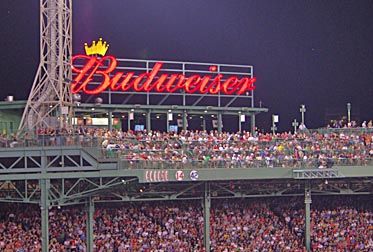 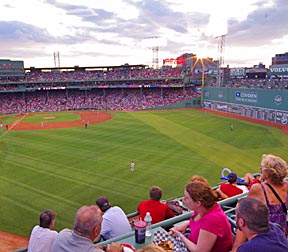 |
The area directly behind home plate (below left) has seen quite a lot of changes over the years — and expensive ones at that. First, the Red Sox constructed a fully enclosed “premium seating level” on the third and fourth levels below the press box. Completed in 1989, it was called “The 600 Club” because that was the number of thickly padded seats it contained. It was renamed “The .406 Club” in 2002 after Ted Williams passed away, because that was his batting average in 1941 — the last time any Major Leaguer batted .400.
Prior to the 2006 season, the Sox reversed course and returned this area to open-air seating, again with two levels. The lower of the two levels is now known as “The EMC Club,” while the level just above it is called “The State Street Pavilion.” This means that the only enclosed area is the press level on the top. The swanky restaurant shown in the right-hand shot below, by the way, is just behind The State Street Pavilion seats..
 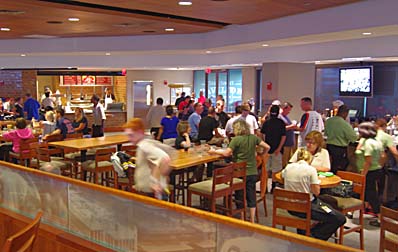 |
While there’s still a trusty hand-operated scoreboard on the front of the Green Monster, the look above and beyond the outfield walls has changed greatly over the years. That’s because the Red Sox have embraced high-definition video screens. The scoreboard in center field beneath the iconic John Hancock sign used to have seven panels of ads and decidedly low-tech graphics. As the shot from behind home plate (below left) shows, there’s now a huge video screen there, with four smaller ads signs attached on the sides (close-up below right). To the left of the center-field scoreboard used to be a black-and-white message board. Today it’s an extra-wide HD video screen. Not only that, formerly there were only ad billboards to the right of the center-field screen. Now you’ll find another high-resolution video screen there, typically used for lineups and messages.
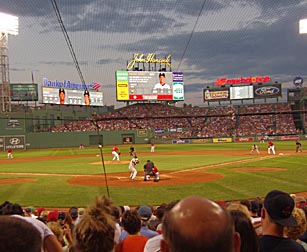 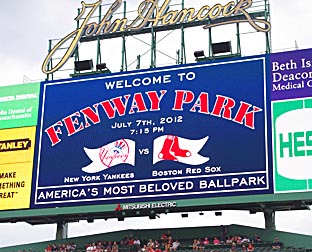 |
And one of the most famous ballpark changes ever took place between the 2002 and 2003 seasons, as the famous Monster Seats were installed. It was quite an engineering project to strengthen the supports behind the Green Monster and provide a tiered platform where the counters and barstools now reside — as this view from behind the Monster in the left-hand photo below attests. The center photo lets you see how these three rows of seats appear from the Coca-Cola Deck. And if you’ve ever wondered what it’s like actually sitting in those Monster Seats, the shot on the right should give you a pretty good idea.
 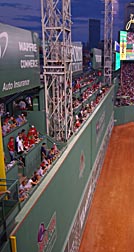  |
Another aspect of Fenway that wouldn’t be recognizable to a Red Sox player or fan from decades ago would be what happens outside of the ballpark prior to games. As you probably know, the Red Sox completely shut down Yawkey Way in front of Fenway for a street festival of sorts. It is crowded, loud and a lot of fun (below left).
Although the roadway isn’t closed on Lansdowne Street behind the outfield, it also has vendors and a party vibe before games (below right). By the way, in the background of the Lansdowne photo below is the famous Prudential Building.
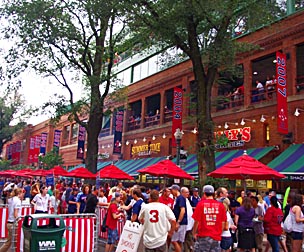 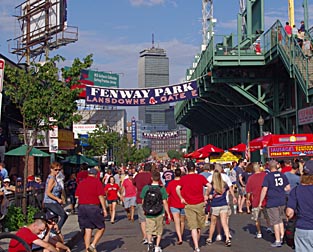 |
So inside and out, Fenway looks absolutely great at 100 years old! If you haven’t been there for awhile — or (heaven forbid) you’ve never taken in a game at Fenway — you really need to come to Boston and make it happen.
After all, you wouldn’t want to be guilty of failing to visit America’s Most Beloved Ballpark on her 100th birthday, would you?
 |
Thanks to Abby DeCiccio of the Red Sox for her help in giving me access to various areas within the ballpark.